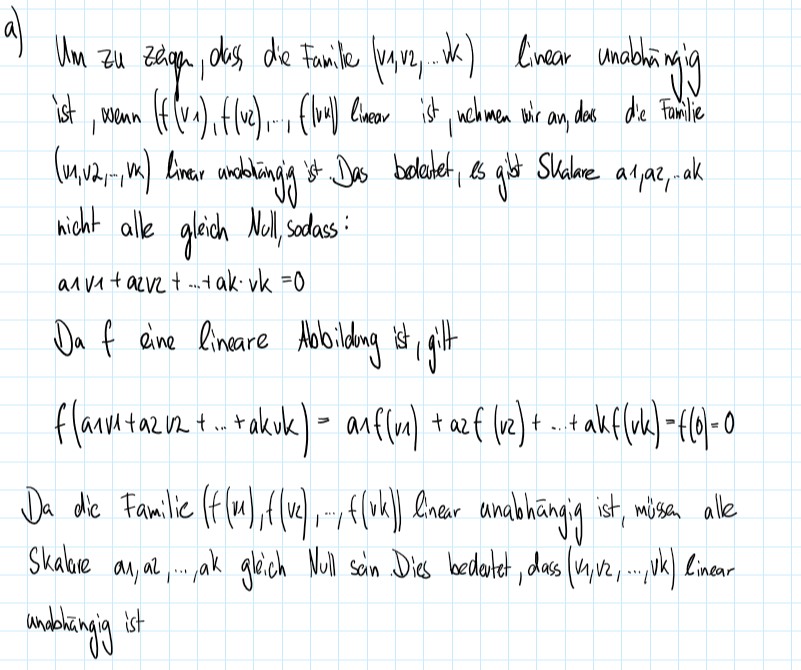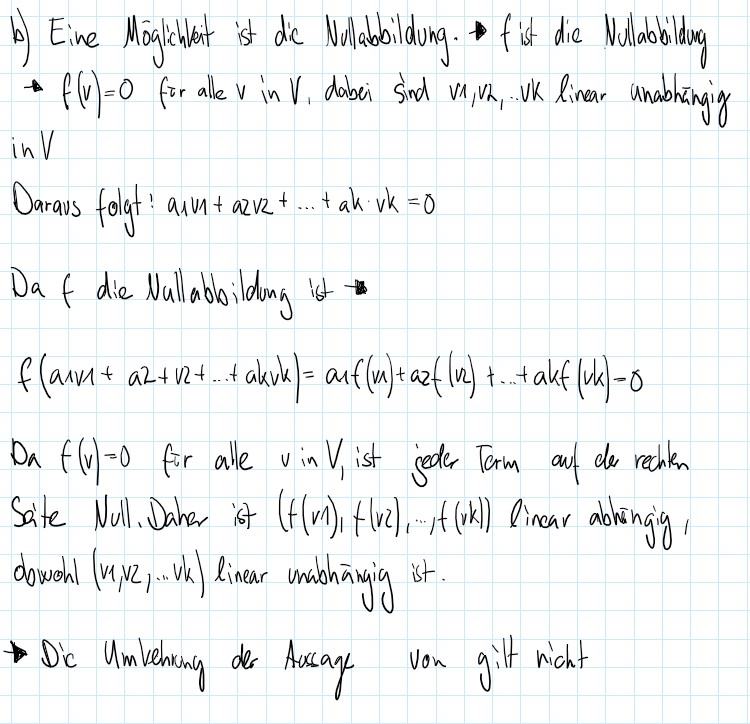Aufgabe Lineare Abbildungen
Es sei \( f: V \rightarrow W \) eine lineare Abbildung zwischen \( \mathbb{R} \)-Vektorräumen \( V \) und \( W \). Seien weiterhin \( \mathbf{v}_{1}, \mathbf{v}_{2}, \ldots, \mathbf{v}_{k} \in V \).
(a) Zeigen Sie: Wenn die Familie \( \left(f\left(\mathbf{v}_{1}\right), f\left(\mathbf{v}_{2}\right), \ldots, f\left(\mathbf{v}_{k}\right)\right) \) linear unabhängig ist, dann ist auch die Familie \( \left(\mathbf{v}_{1}, \mathbf{v}_{2}, \ldots, \mathbf{v}_{k}\right) \) linear unabhängig.
(b) Zeigen Sie, dass die Umkehrung von (a) falsch ist. Genauer:
Finden Sie eine lineare Abbildung \( f: V \rightarrow W \) und Vektoren \( \mathbf{v}_{1}, \mathbf{v}_{2}, \ldots, \mathbf{v}_{k} \in V \), sodass \( \left(\mathbf{v}_{1}, \mathbf{v}_{2}, \ldots, \mathbf{v}_{k}\right) \) linear unabhängig ist und \( \left(f\left(\mathbf{v}_{1}\right), f\left(\mathbf{v}_{2}\right), \ldots, f\left(\mathbf{v}_{k}\right)\right) \) linear abhängig ist. Zeigen Sie dabei die Richtigkeit Ihres Beispiels.
Problem/Ansatz:
Ist mein Ansatz richtig?

Text erkannt:
a) Uim zu zeighe, das, die Familie \( (v 1, v 2, \ldots W) \) linear unabhängig ist, weenn \( \left(f\left(v_{1}\right), f(v e), \ldots, f(v x)\right) \) linear ist, nchmen wir an, das die Fanilie \( (v 1, v 2, \cdots, v k) \) linear undolingigist. Das boletet, es gibt Skalare a1,ar, ak nicht alle gleich Null, Sodass:
\( a \wedge v 1+a c v 2+\ldots+a k \cdot v k=0 \)
Daf eine lineare Abbildong ist, gitt
\( f(a 1 v 1+a 2 v 2+\ldots+a k v k)=a 1 f(v 1)+a 2 f(v 2)+\ldots+a k f(v k)=f(0)=0 \)
Da dic Familic \( (f(u), f(v e), \ldots, f(v k)) \) linear unabhängig ist, müssen alle Skalare an, a2, , ak gleich Null sain. Dies bedeutet, dass \( \left(v_{1}, v_{2}, \ldots, k k\right) \) linear andbhangig ist

Text erkannt:
b) Eine Mogichlbit ist dic Nullabbildung. f'ist die Nullabbildury
\( \rightarrow f(v)=0 \) für alle \( V \) in \( V \), dabei sind \( v a, v R_{1} . . V k \) linear unabhaingig
in \( V \)
Daravs folgt: \( a_{1} v_{1}+a_{2} v 2+\ldots+a k \cdot v k=0 \)
Da f die Nullabbildong ist
\( f(a 1 v 1+a 2+v 2+\ldots+a k v k)=a r f(v)+a 2 f(n)+\ldots+a k f(w k)=0 \)
Saite Null. Daher ist \( (f(v 1), f(v e), \cdots, f(v k)) \) linear abhinging, dowohl \( (v 1, v 2, \ldots k k) \) linear unabhanngig ist.
Dic Umbehring der Axscaye vou gitt nicht